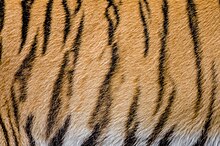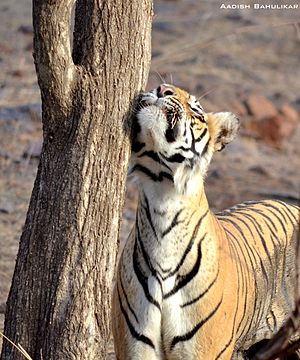
A | B | C | D | E | F | G | H | CH | I | J | K | L | M | N | O | P | Q | R | S | T | U | V | W | X | Y | Z | 0 | 1 | 2 | 3 | 4 | 5 | 6 | 7 | 8 | 9
| Tiger Temporal range:
| |
|---|---|

| |
| A Bengal tigress in Kanha Tiger Reserve, India | |
| Scientific classification | |
| Domain: | Eukaryota |
| Kingdom: | Animalia |
| Phylum: | Chordata |
| Class: | Mammalia |
| Order: | Carnivora |
| Suborder: | Feliformia |
| Family: | Felidae |
| Subfamily: | Pantherinae |
| Genus: | Panthera |
| Species: | P. tigris
|
| Binomial name | |
| Panthera tigris | |
| Subspecies | |

| |
| Tiger distribution as of 2022 | |
| Synonyms[3] | |
The tiger (Panthera tigris) is the largest living cat species and a member of the genus Panthera native to Asia. It has a powerful, muscular body with a large head and paws, a long tail, and distinctive black, mostly vertical stripes on orange fur. It is traditionally classified into nine recent subspecies, though some recognise only two subspecies, namely mainland Asian tigers and island tigers of the Sunda Islands.
Throughout the tiger's range, it inhabits mainly forests, from coniferous and temperate broadleaf and mixed forests in the Russian Far East and Northeast China to tropical and subtropical moist broadleaf forests on the Indian subcontinent and Southeast Asia. The tiger is an apex predator and preys mainly on ungulates such as deer and wild boar, which it takes by ambush. It lives a mostly solitary life and occupies home ranges, which it defends from individuals of the same sex. The range of a male tiger overlaps with that of multiple females with whom he has reproductive claims. Females give birth to usually two or three cubs that stay with their mother for about two years. When becoming independent, they leave their mother's home range and establish their own.
Since the early 20th century, tiger populations have lost at least 93% of their historic range and are locally extinct in West and Central Asia, in large areas of China, and on the islands of Java and Bali. Today, the tiger's range is severely fragmented. The species is listed as Endangered on the IUCN Red List of Threatened Species, as its range is thought to have declined by 53% to 68% since the late 1990s. Major reasons for this decline are habitat destruction and fragmentation due to deforestation, poaching for fur, and the illegal trade of tiger body parts for medicinal purposes. Tigers are also victims of human–wildlife conflict due to encroachment in countries with a high human population density. Tigers sometimes attack and even prey on people.
The tiger is among the most popular of the world's charismatic megafauna. It has been kept in captivity since ancient times and has been trained to perform in circuses and other entertainment shows. The species has been popular in the exotic pet trade. The tiger featured prominently in the ancient mythology and folklore of cultures throughout its historic range and has continued to appear in culture worldwide.
Etymology
The Old English tigras derives from Old French tigre, from Latin tigris, which was a borrowing from Classical Greek τίγρις 'tigris'.[4] In the 1st century, Roman scholar Marcus Terentius Varro argued that the word tigris originates in the Armenian language and means 'arrow', which is also the name of the fast-flowing river Tigris.[5] The Middle Persian tigr also has both meanings; however, today, the connection between 'arrow' and the river's name is doubted, and they are likely to be Latin homonyms.[6]
Taxonomy
In 1758, Carl Linnaeus described the tiger in his work Systema Naturae and gave it the scientific name Felis tigris.[2] In 1929, the British taxonomist Reginald Innes Pocock subordinated the species under the genus Panthera, using the scientific name Panthera tigris.[7][8]
Subspecies
Following Linnaeus's first descriptions of the species, up to nine recent tiger subspecies have been classified; namely the Bengal, Malayan, Indochinese, South Chinese, Siberian, Caspian, Javan, Bali and Sumatran tiger. The Caspian, Javan and Bali tigers have gone extinct in the 20th century and South China tigers survive only in captivity.[9][10][11] The validity of several tiger subspecies was questioned in 1999. Most putative subspecies described in the 19th and 20th centuries were distinguished on the basis of fur length and colouration, striping patterns and body size, hence characteristics that vary widely within populations. Morphologically, tigers from different regions vary little, and gene flow between populations in those regions is considered to have been possible during the Pleistocene. Therefore, it was proposed to recognise only two tiger subspecies as valid, namely P. t. tigris in mainland Asia and P. t. sondaica in the Greater Sunda Islands. Mainland tigers are described as being larger in size with generally lighter fur and fewer stripes, while island tigers are smaller due to insular dwarfism, with darker coats and more numerous stripes.[12] The stripes of island tigers may break up into spotted patterns.[13]
This two-subspecies proposal was reaffirmed in 2015 by a comprehensive analysis of morphological, ecological, and molecular traits of all putative tiger subspecies using a combined approach. The authors proposed recognition of only two subspecies, namely P. t. tigris comprising the mainland populations of continental Asia, and P. t. sondaica comprising the island populations of the Sunda Islands. The continental nominate subspecies P. t. tigris constitutes two clades: a northern clade composed of the Siberian and Caspian tiger populations, and a southern clade composed of all other mainland populations. The authors noted that this two-subspecies reclassification will impact tiger conservation management.[10] It would make captive breeding programmes and future re-wilding of zoo-born tigers easier, as one tiger population could then be used to reinforce another. However, there is a risk that the loss of subspecies uniqueness could lead to fewer protection efforts for specific populations.[14]
In 2017, the Cat Classification Task Force of the IUCN Cat Specialist Group revised felid taxonomy in accordance with the two-subspecies proposal of the comprehensive 2015 study, and recognised the tiger populations in continental Asia as P. t. tigris, and those in the Sunda Islands as P. t. sondaica.[15] This two-subspecies view is still disputed by researchers, since the currently recognised six living subspecies can be distinguished genetically.[14] Results of a 2018 whole-genome sequencing of 32 samples support the Bengal, Malayan, Indochinese, South Chinese, Siberian and Sumatran tigers being distinct monophyletic tiger clades and indicate they descended from a common ancestor around 110,000 years ago.[16] Studies in 2021 and 2023 also affirmed the genetic distinctiveness and separation of these tigers.[17][11]
The following tables are based on the classification of the species Panthera tigris provided in Mammal Species of the World,[9] and also reflect the classification used by the Cat Classification Task Force in 2017:[15]
| Populations | Description | Image |
|---|---|---|
| Bengal tiger | This tiger inhabits the Indian subcontinent.[18] Linnaeus's scientific description of the tiger was based on descriptions by earlier naturalists such as Conrad Gessner and Ulisse Aldrovandi.[2] Bengal tiger skins in the collection of the Natural History Museum, London were described as bright orange-red with shorter fur and more spaced out stripes than northern-living tigers like the Siberian tiger.[8] | 
|
| †Caspian tiger formerly P. t. virgata (Illiger, 1815)[19] | This population lived in west-central Asia, reach as far west as Turkey.[18] Illiger's description was not based on a particular specimen, but he only assumed that tigers in the Caspian area differ from those elsewhere.[19] It was later described having a bright rusty-red coat with thin and closely spaced brownish stripes,[20] and a broad occipital bone.[12] According to genetic analysis, it was closely related to the Siberian tiger.[21] It has been extinct since the 1970s.[22] | 
|
| Siberian tiger formerly P. t. altaica (Temminck, 1844)[23] | This tiger lives in the Russian Far East, Northeast China and possibly North Korea.[18] Temminck's description was based on an unspecified number of tiger skins with long hairs and dense coats that were traded between Korea and Japan. He assumed they originated in the Altai Mountains.[23] The Siberian tiger was later described as having an ochre-yellow winter coat that becomes redder and more vibrant after molting. It has black or dark brown stripes, which are fewer in number.[24] The skull is described as shorter and broader then southern-living tigers.[25] | 
|
| South China tiger formerly P. t. amoyensis (Hilzheimer, 1905)[26] | This tiger historically lived in south-central China.[18] Hilzheimer's description was based on five tiger skulls purchased in Hankou, China. These skulls had shorter carnassials and molars than tigers from India with, a smaller cranium, orbits set closer together and larger postorbital processes. Skins of this tiger were described as being yellowish in colour with rhombus-like stripes.[26] It was noted to have a unique mtDNA haplotype.[15] This tiger may be extinct in wild as there has not been a confirmed sighting since the 1970s.[1] | 
|
| Indochinese tiger formerly P. t. corbetti Mazák, 1968[27] | The tiger occurs on the Indochinese Peninsula.[18] Mazák's description was based on 25 specimens in museum collections that were smaller than tigers from India and had smaller skulls.[27] It was also said to have a darker coat than the Bengal tiger with more stripes; the stripes being narrower and having less "double stripes".[28] | 
|
| Malayan tiger formerly P. t. jacksoni Luo et al., 2004[29] | It was proposed as a distinct subspecies on the basis of mtDNA and micro-satellite sequences that differ from the Indochinese tiger.[29] In pelage colour or skull size, it does not differ significantly from Indochinese tigers.[28] There is no clear geographical barrier between tiger populations in northern Malaysia and southern Thailand.[1] | 
|
| Populations | Description | Image |
|---|---|---|
| †Javan tiger formerly P. t. sondaica (Temminck, 1944)[23] | Temminck based his description on an unspecified number of tiger skins with short and smooth hair.[23] Tigers from Java were small compared to tigers of the Asian mainland. The skull was relatively elongated and, compared to the Sumatran tiger, the stripes were longer, thinner and slightly greater in number.[28] The Javan tiger is thought to have gone extinct by the 1980s.[22] A hair found in 2019 on a fence in South Sukabumi, West Java, was found to be genetically similar to hairs of zoological specimens of the Javan tiger in 2022.[30] | 
|
| †Bali tiger formerly P. t. balica (Schwarz, 1912)[31] | Schwarz based his description on a skin and a skull of an adult female tiger from Bali. He argued that its fur colour is brighter and its skull smaller than of tigers from Java.[31][32] A typical feature of Bali tiger skulls is the narrow occipital plane, which is similar to Javan tigers.[33] The tiger went extinct in the 1940s.[22] | 
|
| Sumatran tiger formerly P. t. sumatrae Pocock, 1929[34] | Pocock described a dark skin of a tiger from Sumatra as the type specimen.[34] It has broader and smaller nasal region than other island tigers[25][28] with many thick stripes.[28] This tiger has particularly long hairs around the face.[18] | 
|
Evolution

The tiger shares the genus Panthera with the lion, leopard, jaguar and snow leopard. Results of genetic analysis indicate that the tiger and snow leopard are sister species and about 2.88 million years ago, the tiger and the snow leopard lineages diverged from the other Panthera species.[35][39]
The fossil species Panthera palaeosinensis of early Pleistocene northern China was described as a possible tiger ancestor when it was discovered in 1924, but modern cladistics place it as basal to modern Panthera.[40][38] Panthera zdanskyi, which lived around the same time and place, was suggested to be a sister taxon of the modern tiger when it was examined in 2014.[38] However, as of 2023, at least two recent studies considered P. zdanskyi likely to be a synonym of P. palaeosinensis, noting that its proposed differences from that species fell within the range of individual variation.[41][42] The earliest appearance of the modern tiger species in the fossil record are jaw fragments from Lantion in China that are dated to the early Pleistocene.[38] Middle- to late-Pleistocene tiger fossils were found throughout China, Sumatra and Java. Prehistoric subspecies include Panthera tigris trinilensis and P. t. soloensis of Java and Sumatra, and P. t. acutidens of China; late Pleistocene and early Holocene fossils of tigers were also found in Borneo and Palawan, Philippines.[43]
Results of a phylogeographic study indicate that all living tigers have a common ancestor 108,000 to 72,000 years ago.[29] A 2022 paleogenomic study of a Pleistocene tiger basal to living tigers concluded that modern tiger populations spread across Asia no earlier than 94,000 years ago. There is evidence of interbreeding between the lineage of modern mainland tigers and these ancient tigers.[44] The potential tiger range during the late Pleistocene and Holocene was predicted using ecological niche modelling based on more than 500 tiger locality records combined with bioclimatic data. The resulting model shows a contiguous tiger range at the Last Glacial Maximum, indicating gene flow between tiger populations in mainland Asia. The tiger populations on the Sunda Islands and mainland Asia were possibly separated during interglacial periods.[45]
The tiger's full genome sequence was published in 2013. It was found to have repeat compositions much like other cat genomes and "an appreciably conserved synteny".[46]
Hybrids
Captive tigers were bred with lions to create hybrids that share physical and behavioural qualities of both parent species; the liger is the offspring of a female tiger and a male lion, and the tigon the offspring of a male tiger and a female lion.[47] The lion sire passes on a growth-promoting gene, but the corresponding growth-inhibiting gene from the female tiger is absent, so that ligers grow far larger than either parent species. By contrast, the male tiger does not pass on a growth-promoting gene, and the lioness passes on a growth inhibiting gene; hence, tigons are around the same size as either species.[48] Breeding hybrids is considered unethical as they are susceptible to obesity and other birth defects.[47]
Characteristics
The tiger has a typical felid morphology; its body is muscular with shortened legs, strong forelimbs, broad paws, a large head and a tail that is about half the length of the rest of its body.[13][49] There are five digits on the front feet and four on the back, all of which have retractile claws that are compact and curved. The ears are rounded, while the eyes have a round pupil.[13] The tiger's skull is large and robust, with a constricted front region, proportionally small, elliptical orbits, long nasal bones, and a lengthened cranium with a large sagittal crest.[50][13] It resembles a lion's skull, with the structure of the lower jaw and length of the nasals being the most reliable indicators for species identification.[50] The tiger has fairly robust teeth and its somewhat curved canines are the longest in the cat family at 6.4–7.6 cm (2.5–3.0 in).[13][51]
The tiger is the largest living felid species, with the Siberian and Bengal tigers being the largest.[13] Bengal tigers average a total length of 3 m (9.8 ft), with males weighing 200–260 kg (440–570 lb) and females weighing 100–160 kg (220–350 lb).[52] Island tigers are the smallest; the Sumatran tiger has a total length of 2.2–2.5 m (7 ft 3 in – 8 ft 2 in) with a weight of 100–140 kg (220–310 lb) for males and 75–110 kg (165–243 lb) for females.[52] The extinct Bali tiger was even smaller.[13] It has been hypothesised that body sizes of different tiger populations may be correlated with climate and be explained by thermoregulation and Bergmann's rule.[13][12]
Coat

The tiger's coat is generally coarse and relatively thin, though the Siberian tiger has a thick winter coat.[13][53] It has a mane-like heavy growth of fur around the neck and jaws and long whiskers, especially in males.[13] Its colouration is generally orange but can vary from light yellow to dark red.[13][43][54] White fur covers the ventral surface, along with parts of the face.[13][55] It also has a prominent white spot on the back of their ears which are surrounded by black.[13] The tiger is marked with distinctive black or dark brown stripes, the patterns of which are unique for each individual.[13][56] The stripes are mostly vertical, but those on the limbs and forehead are horizontal. They are more concentrated towards the posterior and those on the trunk may or may not reach under the belly. The tips of stripes are generally sharp and some may split up or split and fuse again. Tail stripes are thick bands and a black tip marks the end.[57]
Stripes are likely advantageous for camouflage in vegetation with vertical patterns of light and shade, such as trees, reeds and tall grass.[56][58] This is supported by a 1987 Fourier analysis study which concluded that the spatial frequencies of tiger stripes line up with their environment.[59] The tiger is one of only a few striped cat species; it is not known why spotted patterns and rosettes are the more common camouflage patterns among felids.[60] The orange colour may also aid in concealment, as the tiger's prey are dichromats, and thus they may perceive the cat as green and blended in with the vegetation.[61] The white dots on the ear may play a role in communication.[13]
Colour variations

The three colour variants – nearly stripeless snow-white, white and golden – are now virtually non-existent in the wild due to the reduction of wild tiger populations but continue in captive populations. The white tiger has a white background colour with sepia-brown stripes. The golden tiger is pale golden with reddish-brown stripes. The snow-white tiger is a morph with extremely faint stripes and a pale reddish-brown ringed tail. White and golden morphs are the result of an autosomal recessive trait with a white locus and a wideband locus, respectively. The snow-white variation is caused by polygenes with both white and wideband loci.[62] The breeding of white tigers is controversial, as they have no use for conservation. Only 0.001% of wild tigers have the genes for this colour morph, and the overrepresentation of white tigers in captivity is the result of inbreeding. Hence, their continued breeding will risk both inbreeding depression and loss of genetic variability in captive tigers.[63]
Pseudo-melanistic tigers with thick, merged stripes have been recorded in Simlipal National Park and three Indian zoos; population genetic analysis of Indian tiger samples revealed that this phenotype is caused by a mutation of a transmembrane aminopeptidase gene. Around 37% of the Simlipal tiger population has this feature, which has been linked to genetic isolation.[64]
Distribution and habitat

The tiger historically ranged from eastern Turkey and northern Afghanistan to Indochina and from southeastern Siberia to Sumatra, Java and Bali.[13] As of 2022, it inhabits less than 7% of its historical distribution and has a scattered range that includes the Indian subcontinent, the Indochinese Peninsula, Sumatra, the Russian Far East and northeastern China.[1] As of 2020, India had the largest extent of global tiger habitat with 300,508 km2 (116,027 sq mi), followed by Russia with 195,819 km2 (75,606 sq mi).[65]
The tiger mainly lives in forest habitats and is highly adaptable.[52] Records in Central Asia indicate that it occurred foremost in Tugay riverine forests and inhabited hilly and lowland forests in the Caucasus.[66] In the Amur-Ussuri region, it inhabits Korean pine and temperate broadleaf and mixed forests; riparian forests serve as dispersal corridors, providing food and water for both tigers and ungulates.[67] On the Indian subcontinent, it inhabits mainly tropical and subtropical moist broadleaf forests, moist evergreen forests, tropical dry forests, alluvial plains and the mangrove forests of the Sundarbans.[68] In the Eastern Himalayas, it was documented in temperate forest up to an elevation of 4,200 m (13,800 ft) in Bhutan, of 3,630 m (11,910 ft) in the Mishmi Hills, and of 3,139 m (10,299 ft) in Mêdog County, southeastern Tibet.[69][70][71] In Thailand, it lives in deciduous and evergreen forests.[72] In Sumatra, it inhabits lowland peat swamp forests and rugged montane forests.[73]
Population density
Camera trapping during 2010–2015 in the deciduous and subtropical pine forest of Jim Corbett National Park revealed a stable tiger population density of 12–17 individuals per 100 km2 (39 sq mi) in an area of 521 km2 (201 sq mi).[74] In northern Myanmar, the population density in a sampled area of roughly 3,250 km2 (1,250 sq mi) in a mosaic of tropical broadleaf forest and grassland was estimated to be 0.21–0.44 tigers per 100 km2 (39 sq mi) as of 2009.[75] Population density in mixed deciduous and semi-evergreen forests of Thailand's Huai Kha Khaeng Wildlife Sanctuary was estimated at 2.01 tigers per 100 km2 (39 sq mi); during the 1970s and 1980s, logging and poaching had occurred in the adjacent Mae Wong and Khlong Lan National Parks, where population density was much lower, estimated at only 0.359 tigers per 100 km2 (39 sq mi) as of 2016.[76] Population density in dipterocarp and montane forests in northern Malaysia was estimated at 1.47–2.43 adult tigers per 100 km2 (39 sq mi) in Royal Belum State Park, but 0.3–0.92 adult tigers per 100 km2 (39 sq mi) in the unprotected selectively logged Temengor Forest Reserve.[77]
Behaviour and ecology

Camera trap data show that tigers in Chitwan National Park avoided locations frequented by people and were more active at night than during day.[78] In Sundarbans National Park, six radio-collared tigers were most active in the early morning with a peak around dawn and moved an average distance of 4.6 km (2.9 mi) per day.[79] A three-year-long camera trap survey in Shuklaphanta National Park revealed that tigers were most active from dusk until midnight.[80] In northeastern China, tigers were crepuscular and active at night with activity peaking at dawn and dusk; they exhibited a high temporal overlap with ungulate species.[81]
Tigers groom themselves, maintaining their coats by licking them and spreading oil from their sebaceous glands.[82] It will take to water, particularly on hot days. It is a powerful swimmer and easily transverses across rivers as wide as 8 km (5.0 mi).[56] Adults only occasionally climb trees, but have been recorded climbing 10 m (33 ft) up a smooth pipal tree.[13] In general, tigers are less capable tree climbers than many other cats due to their size, but cubs under 16 months old may routinely do so.[83]
Social spacing
Adult tigers lead largely solitary lives. They establish and maintain home ranges or territories, the size of which mainly depends on prey abundance, geographic area and sex of the individual. Males and females defend their home ranges from those of the same sex, and the home range of a male encompasses that of multiple females.[13][56] At Sikhote-Alin Biosphere Reserve, male home ranges overlap with those of up to five females.[84] Two females in the Sundarbans had home ranges of 10.6 and 14.1 km2 (4.1 and 5.4 sq mi).[85] In Panna Tiger Reserve, the home ranges of five reintroduced females varied from 53–67 km2 (20–26 sq mi) in winter to 55–60 km2 (21–23 sq mi) in summer and to 46–94 km2 (18–36 sq mi) during monsoon; three males had 84–147 km2 (32–57 sq mi) large home ranges in winter, 82–98 km2 (32–38 sq mi) in summer and 81–118 km2 (31–46 sq mi) during monsoon seasons.[86] The home range of a male tiger at an elevation of 1,200–4,300 m (3,900–14,100 ft) in Jigme Dorji National Park was estimated at 151.06 km2 (58.32 sq mi) and of a female at 90.34 km2 (34.88 sq mi); their home ranges overlapped entirely.[87] In Huai Kha Khaeng Wildlife Sanctuary, seven resident females had home ranges of 44.1–122.3 km2 (17.0–47.2 sq mi) and four resident males of 174.8–417.5 km2 (67.5–161.2 sq mi).[88] Four male problem tigers in Sumatra were translocated to national parks and needed 6–17 weeks to establish new home ranges of 37.5–188.1 km2 (14.5–72.6 sq mi).[89] At Sikhote-Alin, five resident males had home ranges of 847–1,923 km2 (327–742 sq mi); the home ranges of 14 females were significantly smaller with 248–520 km2 (96–201 sq mi).[84] Ten solitary females in the same reserve had home ranges of 335.9–491.1 km2 (129.7–189.6 sq mi); when they had cubs of up to four months of age, their home ranges declined to 123.8–230.8 km2 (47.8–89.1 sq mi) and steadily grew to 298.2–508.4 km2 (115.1–196.3 sq mi) until the cubs were 13–18 months old.[90]
The tiger is a long-ranging species, and individuals disperse over distances of up to 650 km (400 mi) to reach tiger populations in other areas.[91] Young tigresses establish their first home ranges close to their mother's. Males, however, migrate further than their female counterparts and set out at a younger age to mark out their own area.[92] Four radio-collared females in Chitwan dispersed between 0 and 43.2 km (0.0 and 26.8 mi), and 10 males between 9.5 and 65.7 km (5.9 and 40.8 mi).[93] A young male may have to live as a transient in another male's home range until he is older and strong enough to challenge the resident male. Young males thus have an annual mortality rate of up to 35%. By contrast, young female tigers die at a rate of only around 5%.[92] Tigers mark their home ranges by spraying urine on vegetation and rocks, clawing or scent rubbing trees, and marking trails with faeces, anal gland secretions and ground scrapings.[56][94][95][96] Scent markings also allow an individual to pick up information on another's identity. A tigress in oestrus will signal her availability by scent marking more frequently and increasing her vocalisations. Unclaimed home ranges, particularly those that belonged to a decreased individual, can be taken over in days or weeks.[56]
Male tigers are generally less tolerant of other males within their home ranges than females are of other females. Disputes are usually solved by intimidation rather than outright violence. Once dominance has been established, a male may tolerate a subordinate within his range, as long as they do not live in close quarters. The most serious disputes tend to occur between two males competing for a female in oestrus.[97] Though tigers mostly live alone, relationships between individuals can be complex. Tigers are particularly social at kills, and a male tiger will share a carcass with the females and cubs within this home range and unlike male lions, will allow them to feed on the kill before he is finished with it. Though the female and male act amicably, females are more tense towards each other at a kill.[98][99]
Communication
During friendly encounters and bonding, tigers rub against each other's bodies.[100] Facial expressions include the "defence threat", which involves a wrinkled face, bared teeth, pulled-back ears, and widened pupils.[100][13] Both males and females show a flehmen response, a characteristic grimace, when sniffing urine markings. Males also use the flehman to detect the markings made by tigresses in oestrus.[13] Tigers also use their tails to signal their mood. To show cordiality, the tail sticks up and sways slowly, while an apprehensive tiger lowers its tail or wags it side-to-side. When calm, the tail hangs low.[101]
Tigers are normally silent but can produce numerous vocalisations.[102][103] They roar to signal their presence to other individuals over long distances. This vocalisation is forced through an open mouth as it closes and can be heard 3 km (1.9 mi) away. They roar three or four times in a row, and others respond in kind. Tigers also roar during mating, and a mother will roar to call her cubs to her. When tense, tigers moan, a sound similar to a roar but softer and made when the mouth is at least partially closed. Moaning can be heard 400 m (1,300 ft) away.[13][104]
Aggressive encounters involve growling, snarling and hissing.[105] An explosive "coughing roar" or "coughing snarl" is emitted through an open mouth and exposed teeth.[13][105] In friendlier situations, tigers prusten, a soft, low-frequency snorting sound similar to purring in smaller cats.[106] Tiger mothers communicate with their cubs by grunting, while cubs call back with miaows.[107] When startled they emit a "woof" sound; they emit a deer-like "pok" sound for unknown reasons, but most often at kills.[108][109]
Hunting and diet

The tiger is a carnivore and an apex predator feeding mainly on ungulates, with a particular preference for sambar deer, Manchurian wapiti, barasingha and wild boar. Tigers kill large ungulates like gaur[110] and opportunistically, smaller prey like monkeys, peafowl and other ground-based birds, porcupines and fish.[13][56] Occasional attacks on Asian elephants and Indian rhinoceros have also been reported.[111] More often, tigers take the more vulnerable small calves.[112] They sometimes prey on livestock and dogs in close proximity to settlements.[13] They occasionally consume vegetation, fruit and minerals for dietary fibre.[113]
Tigers learn to hunt from their mothers, which is important but not necessary for their success.[114] Depending on the prey, they typically kill weekly though mothers must kill more often.[52] They usually hunt alone, but families hunt together when cubs are old enough.[115] They travel up to 19.3 km (12.0 mi) per day in search of prey, using vision and hearing to find a target.[116] It also waits at a watering hole for prey to come by, particularly during hot summer days.[117][118] It is an ambush predator and when approaching potential prey, the tiger crouches with its head lowered and hides in foliage. It switches between creeping forward and staying still. Tigers have been recorded dozing off while in still mode and can stay in the same spot for as long as a day, waiting for prey, and launch an attack when the prey is close enough,[119] usually within 30 m (98 ft).[52] If the prey spots it before then, the cat does not pursue further.[117] Tigers can sprint 56 km/h (35 mph) and leap 10 m (33 ft);[120][121] they are not long-distance runners and give up a chase if prey outpaces them over a certain distance.[117]

The tiger attacks from behind or at the sides and tries to knock the target off balance. It latches onto prey with its forelimbs, twisting and turning during the struggle. The tiger generally applies a bite to the throat until its victim dies of strangulation.[13][122][123] It has an average bite force at the canine tips of 1234.3 Newton.[124] Holding onto the throat puts the cat out of reach of the horns, antlers, tusks and hooves.[122][125] Tigers are adaptable killers and may use other methods, including ripping the throat or breaking the neck. Large prey may be disabled by a bite to the back of the hock, severing the tendon. Swipes from the large paws are capable of stunning or breaking the skull of a water buffalo.[126] They kill small prey with a bite to the back of the neck or skull.[127][52] Estimates of the success rate for hunting tigers range from a of low 5% to a high of 50%. They are sometimes killed or injured by large or dangerous prey like gaur, buffalo and boar.[52]
Tigers typically move kills to a private, usually vegetated spot no further than 183 m (600 ft), though they have been recorded dragging it 549 m (1,801 ft). They are strong enough to drag the carcass of a fully grown buffalo for some distance; they rest for a while before eating and can consume as much as 50 kg (110 lb) of meat in one session, but feed on a carcass for several days, leaving little for scavengers.[128]
Enemies and competitors

Tigers sometimes kill sympatric predators.[129][130] In much of their range, tigers share habitat with leopards and dholes and typically dominate both of them, though large dhole packs can drive away a tiger[131] or even kill it.[132] Tigers appear to inhabit the deep parts of a forest while these smaller predators are pushed closer to the fringes.[133] The three predators coexist by hunting different prey.[134] In one study, tigers were found to have killed prey that weighed an average of 91.5 kg (202 lb), in contrast to 37.6 kg (83 lb) for the leopard and 43.4 kg (96 lb) for the dhole.[135] Leopards can live successfully in tiger habitat when there is abundant food and vegetation cover and no evidence of competitive exclusion.[134][136] Nevertheless, leopards avoid areas where tigers roam and are less common where tigers are numerous.[129][137][138]
Tigers tend to be wary of sloth bears, with their sharp claws, quickness and ability to stand on two legs. Tigers sometimes prey on sloth bears by ambushing them when they are feeding at termite mounds.[139] Siberian tigers attack, kill and prey on Ussuri brown and black bears.[13] Brown bears frequently track down tigers to usurp their kills, with occasional fatal outcomes for the tiger.[140][141]
Reproduction and life cycle

The tiger mates all year round, but most cubs are born between March and June, with another peak in September.[142] A tigress is in oestrus for three to six days, in between three and nine week intervals.[13] A resident male mates with all the females within his home range, who signal their receptiveness by roaring and marking.[143][144] Younger, transient males are also attracted, leading to a fight in which the more dominant male drives the usurper off.[142][143] During courtship, the male is cautious with the female as he waits for her to show signs she is ready to mate. She signals to him by positioning herself in lordosis with her tail to the side. Copulation is generally 20 to 25 seconds long, with the male biting the female by the scruff of her neck. After it is finished, the male quickly pulls away as the female may turn and slap him.[143] Tiger pairs may stay together for up to four days and mate multiple times.[145] Gestation ranges from 93 to 114 days, with an average of 103 to 105 days.[142]
A tigress gives birth in a secluded location, be it in dense vegetation, in a cave or under a rocky shelter.[146] Litters consist of as many as seven cubs, but two or three are more typical.[142][146] Newborn cubs weigh 785–1,610 g (27.7–56.8 oz), and are blind and altricial.[146] The mother licks and cleans her cubs, suckles them and viscously defends them from any potential threat.[142] Young open their eyes in a week, can leave the denning site in two months and around the same time they start eating meat.[142][147] The mother only leaves them alone to hunt, and even then she does not travel far.[148] When she suspects an area is no longer safe, she moves her cubs to a new spot, transporting them one by one by grabbing them by the scruff of the neck with her mouth. Death of cubs by predators like dholes, leopards and pythons can cause a mortality rate of 50% during the early months.[149]

After around two months, the cubs are able to follow their mother. They still hide in vegetation when she goes hunting, and she will guide them to the kill. Cubs bond through play fighting and practice stalking. A hierarchy develops in the litter, with the biggest cub, often a male, being the most dominant and the first to eat its fill at a kill.[150] Around the age of six months, cubs are fully weaned and have more freedom to explore their environment. Between eight and ten months, they accompany their mother on hunts.[149] A cub can make a kill as early as 11 months and reach independence around 18 to 24 months of age; males become independent earlier than females.[151] Radio-collared tigers in Chitwan started dispersing from their natal areas at the age of 19 months.[93] Young females are sexually mature at three to four years, whereas males are at four to five years.[13] Generation length of the tiger is about 7–10 years.[152] Wild Bengal tigers live 12–15 years.[153] Data from the International Tiger Studbook 1938–2018 indicate that captive tigers lived up to 19 years.[154]
The father does not play a role in raising the young, but he encounters and interacts with them. The resident male appears to visit the female–cub families within his home range. They socialise and even share kills.[155][156] One male was recorded looking after orphaned cubs whose mother had died.[157] By defending his home range, the male protects the females and cubs from other males.[158] When a new male takes over, dependent cubs are at risk of being killed, as the male attempts to sire his own young with the females. Older female cubs are tolerated but males are treated as potential competitors.[159]
Health and diseases
Tigers are recorded as hosts for various parasites including Diphyllobothrium erinacei, Taenia pisiformis and Toxocara species in India and Physaloptera preputialis, Dirofilaria ursi and Uiteinarta species in Siberia.[13] Canine distemper is known to occur in Siberian tigers.[160] A morbillivirus infection was the likely cause of death of a tigress in the Russian Far East that was also tested positive for feline panleukopenia and feline coronavirus.[161] Blood samples from 11 adult tigers in Nepal showed antibodies for canine parvovirus-2, feline herpesvirus, feline coronavirus, leptospirosis and Toxoplasma gondii.[162]
Threats
The tiger has been listed as Endangered on the IUCN Red List since 1986, as the global tiger population is thought to have continuously declined from an estimated population of 5,000–8,262 tigers in the late 1990s to 3,726–5,578 individuals estimated as of 2022.[1] During 2001–2020, landscapes where tigers live declined from 1,025,488 km2 (395,943 sq mi) to 911,901 km2 (352,087 sq mi).[65] Habitat destruction, habitat fragmentation and poaching for fur and body parts are the major threats that contributed to the decrease of tiger populations in all range countries.[1]

Protected areas in central India are highly fragmented due to linear infrastructure like roads, railway lines, transmission lines, irrigation channels and mining activities in their vicinity.[163] In the Tanintharyi Region of southern Myanmar, deforestation coupled with mining activities and high hunting pressure threatens the tiger population in the area.[164] In Thailand, nine of 15 protected areas hosting tigers are isolated and fragmented offering a low probability for dispersal between them; and four of these do not harbour tigers any more at least since 2013.[165] In Peninsular Malaysia, 8,315.7 km2 (3,210.7 sq mi) of tiger habitat was cleared during 1988–2012, most of it for industrial plantations.[166] Large-scale land acquisitions of about 23,000 km2 (8,900 sq mi) for commercial agriculture and timber extraction in Cambodia contributed to the fragmentation of potential tiger habitat, especially in the Eastern Plains.[167] Inbreeding depression coupled with habitat destruction, insufficient prey resources and poaching is a threat to the small and isolated tiger population in the Changbai Mountains along the China–Russia border.[168] In China, tigers became the target of large-scale 'anti-pest' campaigns in the early 1950s, where suitable habitats were fragmented following deforestation and resettlement of people to rural areas, who hunted tigers and prey species. Though tiger hunting was prohibited in 1977, the population continued to decline and is considered extinct in South China since 2001.[169][170]
Tiger populations in India have been targeted by poachers since the 1990s and were extirpated in two tiger reserves in 2005 and 2009.[171] Between March 2017 and January 2020, 630 activities of hunters using snares, drift nets, hunting platforms and hunting dogs were discovered in a reserve forest of about 1,000 km2 (390 sq mi) in southern Myanmar.[172] Nam Et-Phou Louey National Park was considered the last important site for the tiger in Laos, but it has not been recorded there at least since 2013; this population likely fell victim to indiscriminate snaring.[173] Anti-poaching units in Sumatra's Kerinci Seblat landscape removed 362 tiger snare traps and seized 91 tiger skins during 2005–2016; annual poaching rates increased with rising skin prices.[174] Poaching is also the main threat to the tiger population in far eastern Russia, where logging roads facilitate access for poachers and people harvesting forest products that are vital for prey species to survive in winter.[175]

Body parts of 207 tigers were detected during 21 surveys in 1991–2014 in two wildlife markets in Myanmar catering to customers in Thailand and China.[176] During the years 2000–2022, at least 3,377 tigers were confiscated in 2,205 seizures in 28 countries; seizures encompassed 665 live and 654 dead individuals, 1,313 whole tiger skins, 16,214 body parts like bones, teeth, paws, claws, whiskers, and 1.1 t (1.1 long tons; 1.2 short tons) of meat; 759 seizures in India encompassed body parts of 893 tigers; and 403 seizures in Thailand involved mostly captive-bred tigers.[177] Seizures in Nepal between January 2011 and December 2015 included 585 pieces of tiger body parts and two whole bodies in 19 districts.[178] Seizure data from India during 2001–2021 indicate that tiger skins were the most often traded body parts, followed by claws, bones and teeth; trafficking routes mainly passed through the states of Maharashtra, Karnataka, Tamil Nadu and Assam.[179] A total of 292 illegal tiger parts were confiscated at US ports of entry from personal baggage, air cargo and mail between 2003 and 2012.[180]
Demand for tiger parts for use in traditional Chinese medicine has also been cited as a major threat to tiger populations.[181] Interviews with local people in the Bangladeshi Sundarbans revealed that they kill tigers for local consumption and trade of skins, bones and meat, in retaliation for attacks by tigers, and for excitement.[182] Tiger body parts like skins, bones, teeth and hair are consumed locally by wealthy Bangladeshis and are illegally trafficked from Bangladesh to 15 countries including India, China, Malaysia, Korea, Vietnam, Cambodia, Japan and the United Kingdom via land borders, airports and seaports.[183] Tiger bone glue is the prevailing tiger product purchased for medicinal purposes in Hanoi and Ho Chi Minh City.[184]
Local people killing tigers in retaliation for attacking and preying on livestock is a threat in several tiger range countries, as this consequence of human–wildlife conflict also contributes to the decline of the population.[185][186][187][188][189]
Conservation
| Country | Year | Estimate |
|---|---|---|
| 2022 | 3,167–3,682[190] | |
| 2022 | 573–600[191] | |
| 2022 | 393[191] | |
| 2022 | 316–355[192] | |
| 2022 | 148–189[191] | |
| 2022 | 131[193] | |
| 2022 | <150[191] | |
| 2018 | 114[191] | |
| 2022 | >60[191] | |
| 2022 | 28[191] | |
| Total | 5,634–5,891 |
Internationally, the tiger is protected under CITES Appendix I, banning trade of live tigers and their body parts.[1] In Russia, hunting the tiger has been banned since 1952.[194] In Bhutan, it has been protected since 1969 and enlisted as totally protected since 1995.[195] Since 1972, it has been afforded the highest protection level under India's Wild Life (Protection) Act, 1972.[196] In Nepal and Bangladesh, it has been protected since 1973.[196][183] Since 1976, it has been totally protected under Malaysia's Protection of Wild Life Act.[197] In Indonesia, it has been protected since 1990.[198] In China, the trade in tiger body parts was banned in 1993.[199]
In 1973, the National Tiger Conservation Authority and Project Tiger were founded in India to gain public support for tiger conservation.[171] Since then, 53 tiger reserves covering an area of 75,796 km2 (29,265 sq mi) have been established in the country until 2022.[190]
Myanmar's national tiger conservation strategy developed in 2003 comprises management tasks such as restoration of degraded habitats, increasing the extent of protected areas and wildlife corridors, protecting tiger prey species, thwarting tiger killing and illegal trade of its body parts, and promoting public awareness through wildlife education programmes.[200]
Bhutan's first Tiger Action Plan implemented during 2006–2015 revolved around habitat conservation, human–wildlife conflict management, education and awareness; the second Action Plan aimed at increasing the country's tiger population by 20% until 2023 compared to 2015.[195]
In 2009, the Bangladesh Tiger Action Plan was initiated to stabilise the country's tiger population, maintain habitat and a sufficient prey base, improve law enforcement and foster cooperation between governmental agencies responsible for tiger conservation.[201]
The Thailand Tiger Action Plan ratified in 2010 envisioned increasing the country's tiger populations by 50% in the Western Forest Complex and Dong Phayayen–Khao Yai Forest Complex and reestablish populations in three potential landscapes until 2022.[202]
Zdroj:https://en.wikipedia.org?pojem=Tigers
Text je dostupný za podmienok Creative Commons Attribution/Share-Alike License 3.0 Unported; prípadne za ďalších podmienok. Podrobnejšie informácie nájdete na stránke Podmienky použitia.
Antropológia
Aplikované vedy
Bibliometria
Dejiny vedy
Encyklopédie
Filozofia vedy
Forenzné vedy
Humanitné vedy
Knižničná veda
Kryogenika
Kryptológia
Kulturológia
Literárna veda
Medzidisciplinárne oblasti
Metódy kvantitatívnej analýzy
Metavedy
Metodika
Text je dostupný za podmienok Creative
Commons Attribution/Share-Alike License 3.0 Unported; prípadne za ďalších
podmienok.
Podrobnejšie informácie nájdete na stránke Podmienky
použitia.
www.astronomia.sk | www.biologia.sk | www.botanika.sk | www.dejiny.sk | www.economy.sk | www.elektrotechnika.sk | www.estetika.sk | www.farmakologia.sk | www.filozofia.sk | Fyzika | www.futurologia.sk | www.genetika.sk | www.chemia.sk | www.lingvistika.sk | www.politologia.sk | www.psychologia.sk | www.sexuologia.sk | www.sociologia.sk | www.veda.sk I www.zoologia.sk





